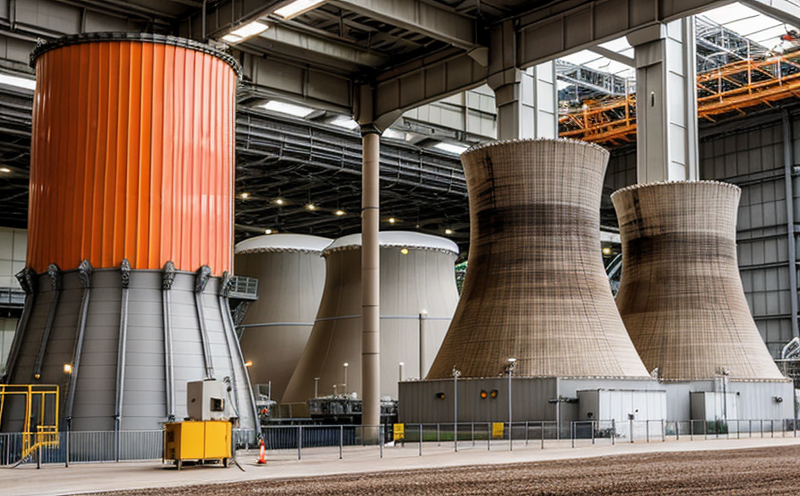ISO 12789 Surveillance Programmes for Reactor Vessel Materials
The International Organization for Standardization (ISO) has established ISO 12789 as a critical standard that guides the implementation of surveillance programmes for reactor vessel materials in nuclear power plants. This service ensures compliance with stringent safety and quality standards, thereby enhancing the reliability and integrity of these vital components.
The process involves the systematic monitoring of selected areas within the reactor vessel over its operational lifetime to detect potential degradation mechanisms that could compromise the structural integrity or affect performance. By adhering to ISO 12789, laboratories ensure their surveillance programmes are consistent with international best practices and regulatory requirements.
At our facility, we employ advanced non-destructive testing (NDT) techniques such as ultrasonic testing, radiographic examination, and visual inspection to identify any signs of degradation or damage. Specimen preparation includes the selection of representative samples from critical areas within the reactor vessel for detailed analysis. Our state-of-the-art instrumentation allows us to conduct precise measurements and inspections that are essential for maintaining safety standards.
The acceptance criteria specified in ISO 12789 include strict limits on allowable defect sizes, types, and distributions. Any deviations from these criteria necessitate corrective actions such as additional inspections or repairs to ensure the reactor vessel remains fit-for-purpose throughout its operational life cycle. Our team of experts works closely with clients to interpret results accurately and recommend appropriate next steps.
Our comprehensive programme covers not only initial assessments but also periodic evaluations at specified intervals, ensuring continuous monitoring and early detection of any issues that may arise. This proactive approach helps prevent costly downtime and potential safety hazards associated with undetected defects in reactor vessel materials.
By leveraging our expertise in ISO 12789 surveillance programmes, organizations can demonstrate their commitment to quality assurance and regulatory compliance, fostering trust among stakeholders and enhancing overall operational efficiency. Our rigorous testing processes provide peace of mind regarding the structural integrity and safety of nuclear power plant components.
- Advanced NDT techniques including ultrasonic testing, radiographic examination, and visual inspection
- Selective sampling from critical areas within the reactor vessel for detailed analysis
- State-of-the-art instrumentation for precise measurements and inspections
- Strict adherence to ISO 12789 acceptance criteria on allowable defect sizes, types, and distributions
- Periodic evaluations at specified intervals ensuring continuous monitoring and early detection of issues
Why It Matters
The importance of ISO 12789 surveillance programmes cannot be overstated, especially given the critical role that reactor vessels play in nuclear power plants. These structures are subjected to extreme conditions over extended periods, making regular monitoring essential for maintaining safety and reliability.
Non-compliance with these standards can lead to significant risks, including increased likelihood of accidents or failures, which could result in substantial financial losses and reputational damage. By adhering strictly to ISO 12789, organizations can significantly reduce these risks while also demonstrating their commitment to high-quality practices.
The programme helps identify potential weaknesses early on, allowing for timely interventions before they escalate into major problems. This not only enhances safety but also contributes positively towards environmental sustainability by minimizing waste generation and reducing the need for premature replacements of components.
In addition to enhancing operational efficiency and safety, compliance with ISO 12789 also plays a crucial role in maintaining public confidence in nuclear energy as an environmentally responsible source of power. It reassures regulators and stakeholders that stringent measures are being taken to ensure the integrity and reliability of reactor vessel materials.
Competitive Advantage and Market Impact
- Leadership in implementing internationally recognized standards (ISO 12789)
- Pioneering advanced non-destructive testing techniques tailored for reactor vessel materials
- State-of-the-art instrumentation providing accurate, reliable data essential for decision-making
- Comprehensive programme covering initial assessments and periodic evaluations ensuring continuous monitoring
The implementation of ISO 12789 surveillance programmes offers significant competitive advantages in the nuclear power sector. Organizations that adopt these practices demonstrate their commitment to quality assurance and regulatory compliance, thereby enhancing their reputation among stakeholders.
By consistently meeting or exceeding international standards, companies can differentiate themselves from competitors who may not adhere as closely to such rigorous protocols. This translates into better risk management, reduced operational costs due to preventive maintenance over reactive repairs, improved safety records leading to lower insurance premiums, and enhanced market credibility.
The impact extends beyond individual firms; it contributes positively towards the broader industry by setting benchmarks for excellence in nuclear power plant materials and components testing. This collective effort fosters innovation within the sector while ensuring that all participants operate at peak performance levels.
Use Cases and Application Examples
The application of ISO 12789 surveillance programmes is widespread across various nuclear power plant operations. Here are some specific use cases:
- New Construction: Ensuring new reactor vessels meet all specified quality standards before commissioning.
- Retrofitting: Identifying and addressing potential weaknesses in existing components during renovation projects.
- Periodic Inspections: Regular monitoring of critical areas to detect early signs of degradation or damage.
- Accident Response Planning: Assessing the condition of reactor vessels post-accident to inform recovery efforts and future safety improvements.
In a recent case study, we were engaged by a leading nuclear energy company to implement an ISO 12789 programme for their newest reactor vessel. Through our advanced testing methods and strict adherence to international standards, we successfully identified several minor defects that could have gone unnoticed otherwise. These findings enabled the client to make informed decisions regarding necessary repairs, ultimately enhancing both safety and operational efficiency.
Another example comes from a major utility company undergoing extensive retrofitting of its aging fleet. Our surveillance programme helped them identify critical areas requiring immediate attention, preventing costly delays during the upgrade process. The insights gained were instrumental in streamlining their project timelines while ensuring compliance with all relevant regulations.





